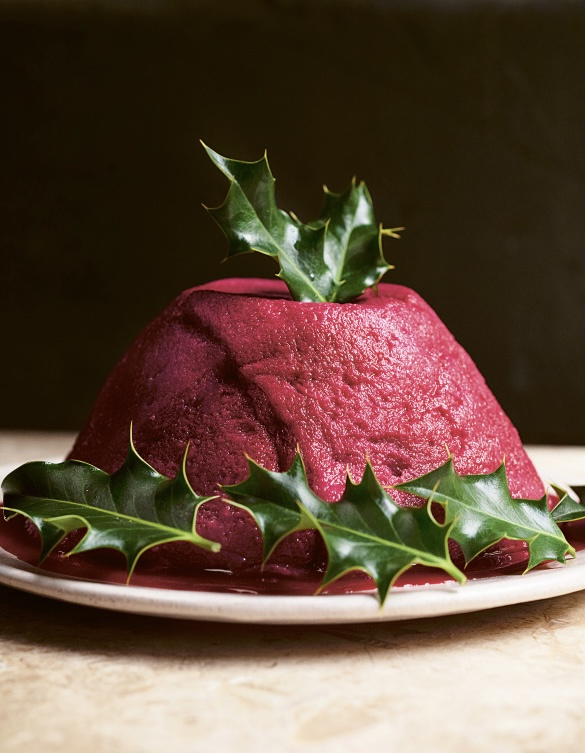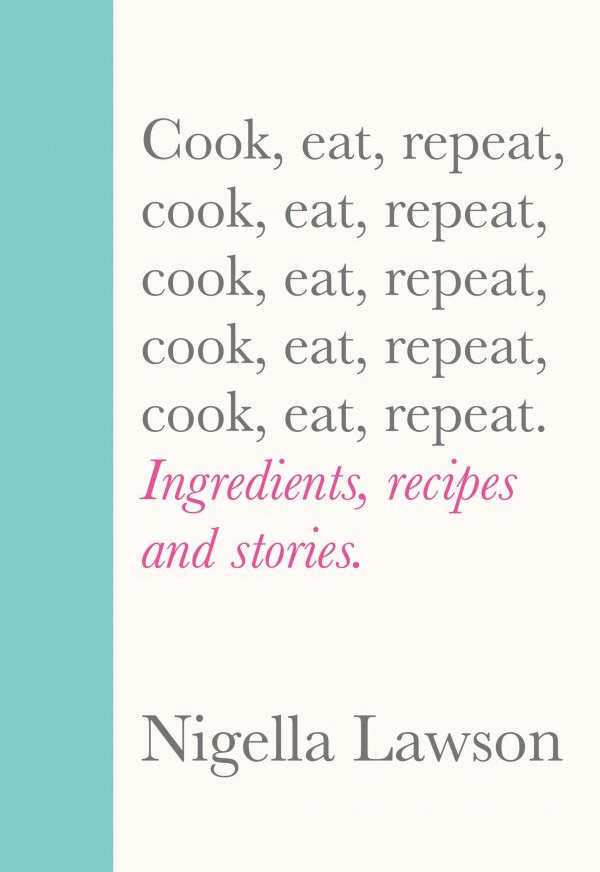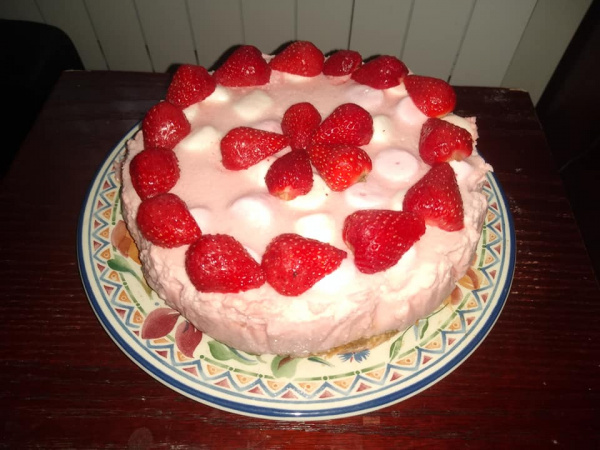Summer Pudding
by Nigella. Featured in COOK EAT REPEATIntroduction
It's true, I admit, that a dessert of compacted berries encased in bread is not an appealing proposition for those who haven't grown up on this seasonal treat, but all it takes is a mouthful to convince. Having fed it to various French and Italian friends over the years, I know this to be the case.
I should, however, say that my version is not the traditional one, which uses one part redcurrants to three parts raspberries. My mother used any berry (excepting strawberry) she could get her hands on, and I do, too. In fact, I go further, adding cherries, which I am more than happy to pit for this. I have left blackcurrants in my list of ingredients, although they are sadly all but impossible to come by unless you grow your own since they are nearly all destined for Ribena these days. But you can get lucky at greengrocers and farmers' markets.
Essentially, though, just bear in mind that you need 850g / 1¾ lb of berries for the 1.1 litre / 4-cup pudding basin (a 2 pint one, in old money) that I use here. Talking of which, I am also untraditional in my approach to this, forsaking the china pudding basin my mother used in favour of a bendy plastic one which makes unmoulding the pudding very much easier.
I know there are a lot of steps to this recipe but it's only because I've described everything in great detail. Summer Pudding is very easy to make: the only daunting moment is the unmoulding! But have faith: the action doesn't warrant the fear.
And please read the Additional Information section at the end of the recipe before proceeding.
It's true, I admit, that a dessert of compacted berries encased in bread is not an appealing proposition for those who haven't grown up on this seasonal treat, but all it takes is a mouthful to convince. Having fed it to various French and Italian friends over the years, I know this to be the case.
I should, however, say that my version is not the traditional one, which uses one part redcurrants to three parts raspberries. My mother used any berry (excepting strawberry) she could get her hands on, and I do, too. In fact, I go further, adding cherries, which I am more than happy to pit for this. I have left blackcurrants in my list of ingredients, although they are sadly all but impossible to come by unless you grow your own since they are nearly all destined for Ribena these days. But you can get lucky at greengrocers and farmers' markets.
Essentially, though, just bear in mind that you need 850g / 1¾ lb of berries for the 1.1 litre / 4-cup pudding basin (a 2 pint one, in old money) that I use here. Talking of which, I am also untraditional in my approach to this, forsaking the china pudding basin my mother used in favour of a bendy plastic one which makes unmoulding the pudding very much easier.
I know there are a lot of steps to this recipe but it's only because I've described everything in great detail. Summer Pudding is very easy to make: the only daunting moment is the unmoulding! But have faith: the action doesn't warrant the fear.
And please read the Additional Information section at the end of the recipe before proceeding.

Share or save this
Ingredients
Serves: 4-6
- 250 grams redcurrants
- 100 grams blackcurrants (if unavailable, increase the quantity of raspberries or blackberries by this amount)
- 200 grams cherries (or replace with an extra 150g / 1 cup of raspberries or blackberries)
- 200 grams blackberries
- 200 grams raspberries
- 75 grams caster sugar
- 125 millilitres cold water
- approx. 12 thinnish (around 1cm / ½-inch) slices cut from a large loaf of white bread
To serve
- fresh mint (optional)
- double cream (very much not)
- 1⅔ cups red currants
- 1½ cups blackcurrants (if unavailable, increase the quantity of raspberries or blackberries by this amount)
- 1¾ cups cherries (or replace with an extra 150g / 1 cup of raspberries or blackberries)
- 1⅓ cups blackberries
- 1⅓ cups raspberries
- ⅓ cup granulated sugar
- ½ cup cold water
- approx. 12 thinnish (around 1cm / ½-inch) slices cut from a large loaf of white bread
To serve
- fresh mint (optional)
- heavy cream (very much not)
Method
- Set aside a couple of clusters of redcurrants for serving. Strip the rest of the currants off their stalks and drop them into a large saucepan that comes with a lid. If you're going to follow me down the untraditional route and use cherries, pit them over the pan so that you don't waste their wonderful juices. Add the rest of the berries, along with the sugar and water.
- Bring the pan to a bubble over medium heat, which will take around 5 minutes (or twice that long for frozen berries). Once it begins to bubble, put on the lid, turn the heat to low and cook the fruit gently for 3-4 minutes; this is just to encourage them to exude their juices.
- Cut the crusts off 10 slices of bread, and line the sides of a 2 pint / 4-cup (1.1 litre) plastic pudding basin with as many of the slices as you need, cutting others in half to fill in the triangular gaps.
- Use a glass that has a diameter just a little bigger than the flat base of your dish to cut out a circle of bread for the base and press it down to sit inside the other slices of bread. And cut the crusts off the other 2 slices, ready for the top.
- Take all the bread out of the basin and form a pattern or layout on your work surface in the order you lined the basin. And if you're not using a flexible plastic basin, you can line a china one with a generous overhang of clingfilm to aid unmoulding later.
- Put a ladleful of juice from the berry pan into a shallow dish and then take each slice in turn, beginning with the big pieces, and dip one side only of each slice into the juice, just to colour it. Line the bowl, purply-red side outwards.
- Ladle out more juice as you need it: you don't want to wet the bread through, just to colour it on one side. Finish with the round bit of bread for the base, and have the slices for the top ready but not dipped yet.
- Ladle in the fruit and juice from the pan to fill the basin. Let the mixture sit in the bread-lined basin for about 5 minutes, and then you'll be able to top up a little more.
- Cut the reserved slices so that they will fit neatly on top, and dip them into a little of the remaining juice, before pressing them down on top, coloured side outwards, to make a lid. You'll have a little juice left, but you'll need it later.
- Once the bread top is on the pudding, cover with food wrap, and sit a plate that fits neatly on it just inside the rim of the bowl, and put something heavy on top to weigh it down as it stands. Leave it out on the counter to cool.
- Strain the leftover juices into a cup, cover and put in the fridge. The best thing to do with the fruit pulp in the sieve is eat it with cream now.
- Put the cooled, weighted pudding in the fridge overnight or for up to 2 days, remembering to take it out in time to come to room temperature before serving.
- Remove the weights, plate and food wrap, and if you're using a plastic basin, give it a gentle squeeze to help the pudding slip out shortly. It may help, too, to slide a small palette knife around the edges of the pudding at the top. Ready? Place your serving plate on top of the basin and then quickly and firmly flip it all, putting the plate on the work surface, with the upturned pudding basin on top. Give the basin another little squeeze and shake and then lift the basin up and off. If the circle of bread that was on the bottom of the basin does stick, gently remove it and place it on top of the turned-out pudding.
- Using a silicon pastry brush, paint any patches of bread that have stayed white with the reserved juice, and decorate the top with the redcurrants you have set aside for this very purpose and, if you have it, a small sprig or two of fresh mint.
- Slice into wedges rather like a cake, making sure everyone gets enough fruit, and serve with double cream in a jug.
- Set aside a couple of clusters of red currants for serving. Strip the rest of the currants off their stalks and drop them into a large saucepan that comes with a lid. If you're going to follow me down the untraditional route and use cherries, pit them over the pan so that you don't waste their wonderful juices. Add the rest of the berries, along with the sugar and water.
- Bring the pan to a bubble over medium heat, which will take around 5 minutes (or twice that long for frozen berries). Once it begins to bubble, put on the lid, turn the heat to low and cook the fruit gently for 3-4 minutes; this is just to encourage them to exude their juices.
- Cut the crusts off 10 slices of bread, and line the sides of a 2 pint / 4-cup (1.1 litre) plastic pudding basin with as many of the slices as you need, cutting others in half to fill in the triangular gaps.
- Use a glass that has a diameter just a little bigger than the flat base of your dish to cut out a circle of bread for the base and press it down to sit inside the other slices of bread. And cut the crusts off the other 2 slices, ready for the top.
- Take all the bread out of the basin and form a pattern or layout on your work surface in the order you lined the basin. And if you're not using a flexible plastic basin, you can line a china one with a generous overhang of clingfilm to aid unmoulding later.
- Put a ladleful of juice from the berry pan into a shallow dish and then take each slice in turn, beginning with the big pieces, and dip one side only of each slice into the juice, just to colour it. Line the bowl, purply-red side outwards.
- Ladle out more juice as you need it: you don't want to wet the bread through, just to colour it on one side. Finish with the round bit of bread for the base, and have the slices for the top ready but not dipped yet.
- Ladle in the fruit and juice from the pan to fill the basin. Let the mixture sit in the bread-lined basin for about 5 minutes, and then you'll be able to top up a little more.
- Cut the reserved slices so that they will fit neatly on top, and dip them into a little of the remaining juice, before pressing them down on top, coloured side outwards, to make a lid. You'll have a little juice left, but you'll need it later.
- Once the bread top is on the pudding, cover with food wrap, and sit a plate that fits neatly on it just inside the rim of the bowl, and put something heavy on top to weigh it down as it stands. Leave it out on the counter to cool.
- Strain the leftover juices into a cup, cover and put in the fridge. The best thing to do with the fruit pulp in the sieve is eat it with cream now.
- Put the cooled, weighted pudding in the fridge overnight or for up to 2 days, remembering to take it out in time to come to room temperature before serving.
- Remove the weights, plate and food wrap, and if you're using a plastic basin, give it a gentle squeeze to help the pudding slip out shortly. It may help, too, to slide a small palette knife around the edges of the pudding at the top. Ready? Place your serving plate on top of the basin and then quickly and firmly flip it all, putting the plate on the work surface, with the upturned pudding basin on top. Give the basin another little squeeze and shake and then lift the basin up and off. If the circle of bread that was on the bottom of the basin does stick, gently remove it and place it on top of the turned-out pudding.
- Using a silicon pastry brush, paint any patches of bread that have stayed white with the reserved juice, and decorate the top with the red currants you have set aside for this very purpose and, if you have it, a small sprig or two of fresh mint.
- Slice into wedges rather like a cake, making sure everyone gets enough fruit, and serve with heavy cream in a jug.
Additional Information
I make a version of this at Christmas (adorned with a sprig of holly) using frozen mixed berries. You'll need the same total weight of frozen summer berries, which come ready-mixed; though if the packets are 400g each, just get two, as the extra 50g is neither here nor there. The only difference between using fresh or frozen berries, in terms of the preparation, is that with frozen it'll take about 10 minutes to get them up to a simmer in the pan, with your stirring frequently to dislodge and mix the berries in the scant liquid.
MAKE AHEAD:
Prepare the pudding up to 3 days ahead. Leave in the basin and refrigerate until needed.
STORE:
Refrigerate leftovers, covered, for up to 2 days. The bread will soften the longer it is stored.
I make a version of this at Christmas (adorned with a sprig of holly) using frozen mixed berries. You'll need the same total weight of frozen summer berries, which come ready-mixed; though if the packets are 400g each, just get two, as the extra 50g is neither here nor there. The only difference between using fresh or frozen berries, in terms of the preparation, is that with frozen it'll take about 10 minutes to get them up to a simmer in the pan, with your stirring frequently to dislodge and mix the berries in the scant liquid.
MAKE AHEAD:
Prepare the pudding up to 3 days ahead. Leave in the basin and refrigerate until needed.
STORE:
Refrigerate leftovers, covered, for up to 2 days. The bread will soften the longer it is stored.







Tell us what you think
Thank you {% member.data['first-name'] %}.
Explore more recipesYour comment has been submitted.
What 2 Others have said
-
Posted by grannyanny on 25th July 2022
-
Posted by Clairette on 21st July 2022
Show more commentsWe, a household of two, enjoy summer pudding on a regular basis during the berry season. I buy a white sliced loaf and stow it in the freezer for easy access. Yesterday I briefly cooked off (with sugar) the last of the frozen cranberries which I mixed with the fresh seasonal fruit. Brilliant!
Nigella was wright, I, as a Belgian had never seen something like this before. In Cook, Eat, Repeat, I have the Dutch edition, I came across this beautiful pudding for the first time. So, since it also is the Cookalong of this month, and we celebrate our national day the 21st of July, I felted like making this delicious 'fruitcake'. And delicious it was!